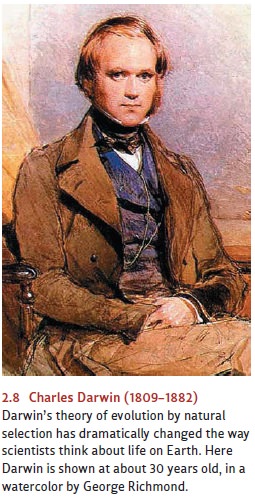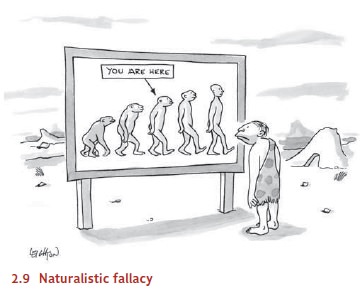Chapter: Psychology: The Genetic and Evolutionary Roots of Behavior
The Principles of Natural Selection
The Principles
of Natural Selection
Much of what we know about
evolution grows out of the pioneering work of Charles Darwin. Charles Darwin
(1809–1882; Figure 2.8) was an English naturalist who, from an early age, was
so engrossed in outdoor pursuits that he habitually neglected his schoolwork.
“To my deep mortification,” Darwin later recalled, “my father once said to me,
‘You care for nothing but shooting, dogs, and rat-catching, and you will be a
disgrace to yourself and all your family.’”

Darwin’s father, Robert, tried
sending Charles to the University of Edinburgh for medical school (Desmond
& Moore, 1991). Robert was a graduate himself, as was his own father.
Charles, however, was bored by the lectures and horrified by the violence and
gore of surgery, which in those days was performed without anesthesia.
Robert next sent Charles to
Christ’s College, Cambridge, to study for a career as a clergyman. There,
Charles discovered a new hobby: beetle collecting. It seemed, yet again, that
his father’s worst fears were being realized. But Charles had by then become a
promising student of natural history. He sufficiently impressed his botany
instructor, John Steven Henslow, that Henslow recommended him for the position
of captain’s companion on a voyage to South America aboard the HMS Beagle, a ship sur-veying the coast of
South America for the British Royal Navy. Against his better judg-ment, Robert
let Charles go. On that voyage Darwin made observations that led, in 1859, to
his publication of an extraordinary and world-changing book, On the Originof Species.
Across the 19th century, it had
become clear to scientists that the creatures populating the planet were
markedly different from those that had been around in earlier epochs; the
fossil record told them this. But what had produced the change? Darwin’s
thinking about this issue was shaped by the diversity of creatures he observed
during the Beagle’s voyage—and, in
particular, the diversity of creatures he saw on the Galápagos Islands, off the
coast of Ecuador. There he noticed, for example, that the local finches varied
consider-ably in the sizes and shapes of their beaks.
In reflecting on the finches,
Darwin began to develop the first of his great ideas: the descent of all life
from a common origin. He hypothesized that all of the finch species on the
islands were descendants of a single type of finch that had colonized the
islands long ago. This led him to consider a broader notion—that all life on Earth had a shared origin,
so that all creatures had descended from an ancient common ancestor. In this
view, modern species had emerged—through some process of modification—from this
shared ancestor. But how did this modification take place?
The answer to this question—the
notion of evolution through natural selection— was Darwin’s second great idea,
but it didn’t occur to him until years later, when he read the works of the
English economist Thomas Malthus (1776–1834). Malthus noted that living things
reproduce rapidly enough so that populations are always growing—and, crucially,
growing more rapidly than the food supply is. As a result, shortages of
resources are inevitable; the consequence is that some individuals will
survive, but others will not. That, for Darwin, was the key.
Which individuals would do well
in this competition for resources, and which would do poorly? Darwin realized
that the answer was linked to his observations of how individuals in a species
differed from each other. A finch with a wide bill might be better able to
crack open seeds than its narrow-billed fellow, and so a wide-billed finch
would have an advantage in the competition for food. This advantage wouldn’t
matter when food was plentiful, but it would be crucial when—as Malthus had
noted—the shortage inevitably arrived. In that circumstance, the wide-billed
finch would be more likely to survive and eventually to reproduce. Darwin also
knew that offspring tend to resemble their parents in many ways (although he
did not know the mechanism of this transmission), and so the wide-billed finch
was likely to have wide-billed progeny. A narrow-billed finch, on the other
hand, might not survive long enough to reproduce; so obviously, it would not
contribute any narrow-billed descendants to the next gener-ation. The upshot of
all this is that the next generation would contain more wide-billed birds, and
fewer narrow-billed birds, than the generation before.
Of course, the same logic would
also apply to other populations of organisms. For example, fish vary in their
coloration, and those that are slightly darker in color might be better
camouflaged against the river’s bottom—and so they’re more likely to escape
predators. Again, this would help the darker-colored fish survive long enough
to repro-duce, so they could leave behind offspring that would inherit their
coloration. In this way, there would be a greater number of dark-skinned fish,
and fewer light-colored ones, in the next generation.
Darwin called this process natural selection, and he realized that the process, if repeated generation after
generation, could produce large changes in a population. Darwin termed these
changes transmutation, but they are
now called evolution. Thus, if
dark-colored fish are more likely to reproduce in this generation and the next,
and the next after that, eventually many (and perhaps most) of the surviving
fish will be the descendants of dark-colored ancestors and probably will be
dark-colored themselves. In this way, a trait that renders some members of a
population better adapted to survive and reproduce in their particular
environment will become more and more common— leading, over the generations, to
a change in the entire population.
In these examples, variations in
a population of animals (bill width in the finch, or coloration of the fish)
give some members a survival advantage that allows them to have more offspring
than others do. But not all variations have this effect, and which varia-tions
are beneficial depends largely on the organism’s environment. If, as we noted,
food is plentiful, then it may not matter how wide the finch’s bill is.
Likewise, if there are few predators, the light-colored fish may fare as well
as the dark ones. Even if pred-ators are numerous, the dark-colored fish will
benefit only if the river bottom is dark. If the river bottom is sandy, then
the light-colored fish might be better camouflaged. Notice, then, that we
cannot think of this selection process as favoring the “better” or “more
advanced” organism. Instead, evolution favors the organism that is better
adapted to survive and reproduce within the environment currently in place. If
the environment changes (e.g., a sandy river bottom becomes muddy), then the
pattern of selective advantages will change as well.
This last point is important
enough to deserve special emphasis. In thinking about evo-lution, it’s
important to avoid the naturalistic
fallacy—the idea that anything “natural” is “good”—or the (related) idea
that more recently evolved traits are “better” than those
that evolved earlier,
so that natural
selection “improves” or “advances” a species (Figure 2.9). These
ideas are mistaken. As we’ve just discussed, natural selection depends only on
whether an organism is well suited to its current environment. The mechanisms
of evolution certainly have no way
to peer into
the future, to know
which traits will
serve the organism well in
environments to come. Indeed, sometimes natural selec-tion can favor traits
that confer an advantage within one environment but later can harm
the organism when the environment changes.

We need to be clear, therefore,
that the process of evolution has no foresight and has no value judgments
attached to it. Evolution is a mat-ter of survival and reproduction—and that is
all. Even so, evolution is a process that powerfully and consistently shapes
all life on earth.
Related Topics